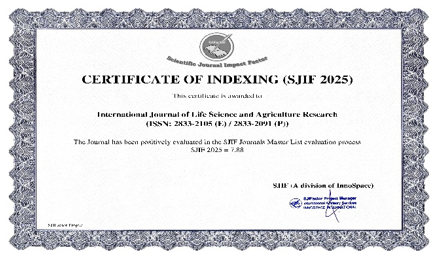Detection of Plant Location Based on Spectral Analysis Using GIS, GPS and Remote Sensing
DOI:
https://doi.org/10.55677/ijlsar/V03I6Y2024-07Keywords:
plant scale husbandry, spectral analysis, RTK-GPS, GISAbstract
In this study, plant position determination was made based on multispectral remote sensing for high-precision agricultural applications targeting the plant itself. In order to determine the plant location, silage corn was planted. Ground control points were fixed for geo-referencing purposes on the subjects determined for the purpose of taking images. Multispectral images were taken with a UAV and plants were detected by image processing after spectral analysis. The plant positions in the images were determined with GIS and the difference between the real plant positions measured with RTK-GPS was determined by calculating rmse values. 96% of the plants in all images taken could be identified. The average rmse value calculated using the coordinates of the plants detected in the images and the real plant coordinates determined by RTK-GPS was found to be 87.99 mm.
References
Aggarwal, S. (2004). Principles of remote sensing. Satellite Remote Sensing and GIS Applications in Agricultural Meteorology, 23(2), 23-28.
Bharathkumar, L., & Mohammed-Aslam, M. A. (2015). Crop pattern mapping of Tumkur Taluk using NDVI technique: A remote sensing and GIS approach. Aquatic Procedia, 4, 1397-1404. https://doi.org/10.1016/j.aqpro.2015.02.181
Blackmore, B. S., & Griepentrog, H. W. (2002). A future view of precision farming. In Proceedings ‘Precision Agriculture Tage’, Bonn, KTBL, Darmstadt, Germany, p. 131–145.
Carlson, T. N., & Ripley, D. A. (1997). On the relation between NDVI, fractional vegetation cover, and leaf area index. Remote Sensing of Environment, 62(3), 241-252.
Curran, P. A. (1985). Principles of Remote Sensing. Longman Group Limited, United Kingdom.
Fadl, M. E., AbdelRahman, M. A., El-Desoky, A. I., & Sayed, Y. A. (2024). Assessing soil productivity potential in arid region using remote sensing vegetation indices. Journal of Arid Environments, 222, 105166. https://doi.org/10.1016/j.jaridenv.2024.105166
Griepentrog, H.-W., & Blackmore, B. (2007). Autonomous crop establishment and control system. VDI Berichte, 2001, 175.
Griepentrog, H.-W., Nørremark, M., Nielsen, H., & Blackmore, B. (2003). Individual plant care in cropping systems. Proceedings 4th European Conference on Precision Agriculture, Berlin, Germany, 247-258.
Griepentrog, H.-W., Nørremark, M., Nielsen, H., & Blackmore, B. (2005). Seed mapping of sugar beet. Precision Agriculture, 6(2), 157-165.
Hatfield, J. L., Prueger, J. H., Sauer, T. J., Dold, C., O’brien, P., & Wacha, K. (2019). Applications of vegetative indices from remote sensing to agriculture: Past and future. Inventions, 4(4), 71.
Huang, S., Tang, L., Hupy, J. P., Wang, Y., & Shao, G. (2021). A commentary review on the use of normalized difference vegetation index (NDVI) in the era of popular remote sensing. Journal of Forestry Research, 32(1), 1-6. https://doi.org/10.1007/s11676-020-01155-1
Kavak, K. Ş. (1998). Uzaktan algılamanın temel kavramları ve jeolojideki uygulama alanları. Jeoloji Mühendisliği Dergisi, 21(1), 63-74.
Li, C., Li, H., Li, J., Lei, Y., Li, C., Manevski, K., & Shen, Y. (2019). Using NDVI percentiles to monitor real-time crop growth. Computers and Electronics in Agriculture, 162, 357-363. https://doi.org/10.1016/j.compag.2019.04.026
Matas-Granados, L., Pizarro, M., Cayuela, L., Domingo, D., Gómez, D., & García, M. B. (2022). Long-term monitoring of NDVI changes by remote sensing to assess the vulnerability of threatened plants. Biological Conservation, 265, 109428.
Myneni, R. B., Hall, F. G., Sellers, P. J., & Marshak, A. L. (1995). The interpretation of spectral vegetation indexes. IEEE Transactions on Geoscience and Remote Sensing, 33(2), 481-486. https://doi.org/10.1109/TGRS.1995.8746029
Ouzemou, J. E., El Harti, A., Lhissou, R., El Moujahid, A., Bouch, N., El Ouazzani, R., ... & El Ghmari, A. (2018). Crop type mapping from pansharpened Landsat 8 NDVI data: A case of a highly fragmented and intensive agricultural system. Remote Sensing Applications: Society and Environment, 11, 94-103. https://doi.org/10.1016/j.rsase.2018.05.002
Patterson, T. A., McConnell, B. J., Fedak, M. A., Bravington, M. V., & Hindell, M. A. (2010). Using GPS data to evaluate the accuracy of state-space methods for correction of Argos satellite telemetry error. Ecology, 91(1), 273-285.
Pôças, I., Calera, A., Campos, I., & Cunha, M. (2020). Remote sensing for estimating and mapping single and basal crop coefficients: A review on spectral vegetation indices approaches. Agricultural Water Management, 233, 106081. https://doi.org/10.1016/j.agwat.2020.106081
Tillett, N., Hague, T., & Marchant, J. (1998). A robotic system for plant-scale husbandry. Journal of Agricultural Engineering Research, 69(2), 169-178.
Vatandaş, M., Güner, M., & Türker, U. (2005). Hassas Tarım Teknolojileri. TMMOB Ziraat Mühendisleri Odası, 6(3-7).
Waldhoff, G., Lussem, U., & Bareth, G. (2017). Multi-data approach for remote sensing-based regional crop rotation mapping: A case study for the Rur catchment, Germany. International Journal of Applied Earth Observation and Geoinformation, 61, 55-69. https://doi.org/10.1016/j.jag.2017.04.009
Downloads
Published
Issue
Section
License
Copyright (c) 2024 International Journal of Life Science and Agriculture Research

This work is licensed under a Creative Commons Attribution 4.0 International License.












